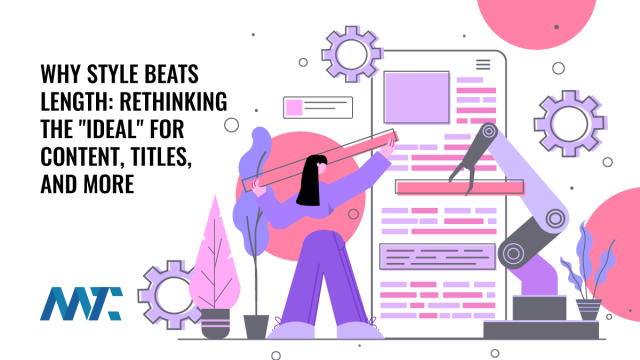For years, marketers and creators have obsessed over ideal lengths. We’ve seen precise character counts for subject lines, word counts for blog posts, and minute markers for video drop-off points. But here’s the uncomfortable truth: there’s no magic number.
How content is styled, positioned, and consumed matters more than length. A perfectly short subject line that fails to compel is worse than a longer one that drives curiosity. A tightly edited video that doesn’t deliver value won’t outperform a longer one that hooks viewers through strategic pacing. Style trumps strict limits across every format—email, SEO, social, video, or podcasts.
This isn’t to say length doesn’t matter at all. But it should be a strategic decision, not a rule to follow blindly. Here’s how to reframe the ideal length myth across major content channels.
Email Subject Lines
Instead of focusing on character limits (like the often-cited 41-character sweet spot), consider what appears first in a user’s inbox preview—and how it makes them feel. Front-load key terms or emotional triggers. Use verbs over filler. Unlock Your Bonus Now will outperform Here’s Something You Might Like, not because it’s shorter, but because it’s more directive and relevant.
Even mobile truncation isn’t the enemy if the first few words spark curiosity. For example, Your 30-day results are… leaves a compelling cliffhanger even when cut off.
SEO Titles and Meta Descriptions
SEO titles aren’t just about fitting into the pixel-width limit Google enforces. While keeping titles under 60 characters avoids truncation, that should never come at the expense of clarity or intent. The positioning of keywords matters more. A format like 12 Proven Strategies to Boost Engagement places important terms early for indexing and entices clicks through specificity.
Meta descriptions, similarly, aren’t rankings drivers—but they influence click-through behavior. Make them compelling, not just compliant. Focus on the problem you’re solving or the curiosity you can trigger.
Blog Posts and Articles
There’s no one-size-fits-all length for written content. Yes, longer content can rank well because it demonstrates depth. However, even 300-word answers can dominate FAQ-style SERPs if structured well.
Style wins by offering precise sectioning, scannable subheadings, and reader-focused design. Long-form pieces benefit from TOCs, summaries, pull quotes, and multimedia. Shorter content works when it’s direct, decisive, and tailored to search intent. The myth of the modern short attention span doesn’t mean readers don’t engage deeply—they need a reason to do so.
Social Media Posts
Ideal post lengths vary widely by platform, but whether the post stops the scroll is even more important. On X (formerly Twitter), sharp hooks and intentional formatting can make a longer thread more engaging than a short, cryptic one. On LinkedIn, posts that tell stories or invite conversation tend to outperform sterile one-liners, even if they’re twice as long.
Instagram captions, too, can be paragraphs long if they’re personal or value-rich. The key is readability and relevance—line breaks, emojis (used wisely), and direct engagement tactics matter more than word counts.
Video Content
Short-form videos have surged, but that doesn’t mean long-form is dead. YouTube continues to reward engagement, not duration alone. What matters most is structured pacing: the first few seconds must tease the payoff, and breadcrumbing valuable moments throughout keeps viewers invested.
Whether it’s a 15-second TikTok or a 10-minute tutorial, style decisions—like open loops, surprise, and on-screen prompts—drive retention better than length alone.
Podcasts
While average episode lengths have dropped, successful podcasts still vary wildly—some thrive in the 12–15-minute range, others over an hour. What separates high-retention shows isn’t time—it’s production value, host delivery, and narrative structure.
Listeners stay engaged when there’s a clear flow: cold opens, teasers, expert moments, takeaways, and recaps. Segmenting longer podcasts with musical or tonal cues helps listeners follow along without fatigue.
Webinars and Live Events
Here, interactivity and value-per-minute are the real differentiators. A 45-minute webinar can feel shorter than a 20-minute one if the former effectively uses audience polls, Q&A moments, and story arcs. Focus less on duration and more on how you’re guiding attention and layering insight.
Reframe the Question
Instead of asking How long should it be? ask:
What is the audience expecting?
Where will this content be consumed?
How can I create early engagement and sustain it?
What structure makes this format more accessible, intriguing, or useful?
The Role of AI in Shaping Content Perception
As artificial intelligence becomes more embedded in how content is created, consumed, and curated, an ideal length becomes even less relevant. What matters now is the substance and structure of the content, because increasingly, the audience isn’t always human—it’s AI.
Many professionals already rely on AI tools to generate, rewrite, or summarize content for newsletters, social posts, meeting notes, or research briefs. These systems don’t evaluate content based on character counts—they identify core ideas, parse structure, and assess coherence. Whether it’s a 2,000-word article or a 60-second video transcript, AI can efficiently extract and reshape it for other formats and channels if the content has clear value and a logical flow.
This evolution will only accelerate. AI summarizers, copilots, and recommendation engines will prioritize organized, skimmable content rich in signal—not fluff. So instead of worrying whether your blog is too long or your video too short, the better question is:
Does this deliver insight, clarity, or utility at every point?
If so, it will perform, whether consumed directly by a human or distilled by an AI.
Quality, not length, becomes the signal. In the AI age, what stands out is not brevity or verbosity, but how well your content holds meaning under compression or expansion. That’s the new benchmark for effectiveness.
©2025 DK New Media, LLC, All rights reserved | Disclosure
Originally Published on Martech Zone: Why Style Beats Length: Rethinking the “Ideal” for Content, Titles, and More

